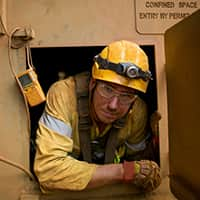Safety Training for Working in Confined Spaces
Written by Staff Writer

Tight spaces are uncomfortable and restrictive at the best of times. Some restrictive environments are dangerous — even deadly.
If your job involves cramped confines like vaults, storage bins, tanks, home crawl spaces and other closed-in areas, confined space hazards training can keep you safe on the job.
This article will help you understand the dangers and choose the right course for your job.
What Are Confined Spaces?
OSHA defines confined spaces according to specific criteria. These tight spots in the workplace have the following characteristics:
- Is not a space that an employee works in continuously
- Not designed for people necessarily, though people do work in them occasionally
- Entry or exit is restricted in some way
- Has enough room for employees to fully enter the space and do work
Such areas are difficult for individuals to enter, traverse and exit. But OSHA defines an additional, more hazardous class of restricted environments: permit-required confined spaces. A permit-required confined space has one or more of the following:
- A potentially hazardous atmosphere
- Possibility of entrapment or asphyxiation due to converging or sloping wall or ceiling construction
- Materials that might engulf someone
- Another recognized health or safety hazard
OSHA requires that these areas be kept under observation. Posters or other notifications must be used as warnings. Only those with a permit are allowed to work in these conditions. Employers must develop, implement and enforce a confined space permit system if such an environment is present on the jobsite.
Confined space entry training is essential. The right coursework helps employees develop the necessary confined space awareness to navigate these enclosures with fewer injuries and challenges.
Who Needs Training?
Personnel who operate in tight conditions must be adequately trained. OSHA sets separate confined space safety training requirements for construction and general industry needs. These roles include:
- Workers who must enter the space for work tasks
- Attendants who monitor these areas
- Space entry and rescue team members
- Supervisors
Each of these duties plays a specific role in managing the hazards of these work areas. Some jobs, like a mechanic or sump technician, require workers to enter the space to do work. Others, like supervisors, monitor these areas and remove any persons who aren't authorized to enter or work there.
Proper instruction teaches you about each of these roles and their responsibilities. After all, it isn't just construction workers, miners or pest control professionals who may succumb to the effects of these hazards.
Law enforcement officers, firefighters or other emergency workers may need access to these areas to perform rescues. The 1985 Kentucky sewer accident, which resulted in the deaths of three sanitation workers and one police officer, proved that instruction for on-site workers and rescue personnel is equally important to mitigate injuries and deaths.
Conditions inside these areas often require specialized equipment, like respirators, to navigate safely. The Kentucky incident demonstrated how important it is to properly label such areas and enforce entry conditions in order to alert everyone of the possible dangers.
Professionals who work in these areas regularly may know about the risks involved. But those less familiar with the area, like first responders, may not. Targeted instruction (and visual reminders, like safety posters) can prevent disasters by ensuring everyone knows what they're up against whenever they venture into a tight spot.
Training Requirements
OSHA requires all personnel who work in and around restrictive environments to complete a confined space training course. Both non-permit and permit space workers must complete training before beginning relevant duties.
Further, OSHA requires employers to provide additional training in event of the following:
- The employee demonstrates skill or work deficits that affect job performance or safety
- The nature of the employee's job changes
- New hazards present themselves
- Spaces or environments change
Employers are obligated to keep records of these trainings.
Where to Get Confined Space Training Certification
You can complete your mandatory safety education online. There's no need to sit in a classroom and schedule lessons with an in-person instructor. All our classes are available 100% online from any internet-connected device.
What You'll Learn
OSHA Education Center's Permit-Required Confined Spaces for Construction course covers key hazards for workers in the industry. Lessons provide you with the knowledge you need to work more safely in confined spaces.
Course topics include:
- Recognition of confined spaces, including permit and non-permit environments
- OSHA standards and the procedures that support them in restrictive work areas
- Appropriate personal protective equipment (PPE)
- What to do if there is an emergency when you're working in these areas
Our confined space entry training course includes practical examples and in-depth information. Spanish-language lessons are also available. All courses are compliant with the OSHA standards found in 1926 Subpart AA or 1910.146.
Start Today
Once you sign up, you have 90 days to complete your training. But you can finish the class and download your certificate in as little as an hour! Log in at any time with 24/7 access from your laptop, tablet or mobile device.
Enroll now and satisfy OSHA confined space training requirements for your job today!
